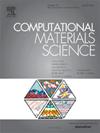Electrical conductivity of graphene/copper composites at lattice scale
Abstract
Graphene/copper composites are potential structure-function integrated materials. Different from previous micro-nano scale composites, graphene/copper lattice-scale composites and their effects on electrical conductivity are investigated in this work. Using the first-principles calculation to explore the effects of different numbers of graphene layers on the properties of graphene/copper composites, it is found that with the increase of graphene layer numbers, the interfacial bonding strength improves, but the electrical properties show a decreasing trend due to the electron scattering and increasing Cu–C layer distance. The single-layer graphene/copper composite has the most excellent electrical properties, with the highest density of states at the Fermi level and the most charge transfer. A series of layered-structural composites at lattice scale are screened, and their electrical properties and dynamic stability are also predicted. These composites rely on metallic bonding to connect copper and carbon atoms, most of which show obvious vertical charge transfer and high conductivity, with short Cu–C layer distance and alternating arrangement of metal layers and hexagonal carbon atoms. CuC2 (derived from MgB2) has the highest average conductivity and dynamic stability and can be considered an ideal lattice-scale composite. The development of new lattice-scale composites is significant for the future research of graphene/copper composites.


 求助内容:
求助内容: 应助结果提醒方式:
应助结果提醒方式:


